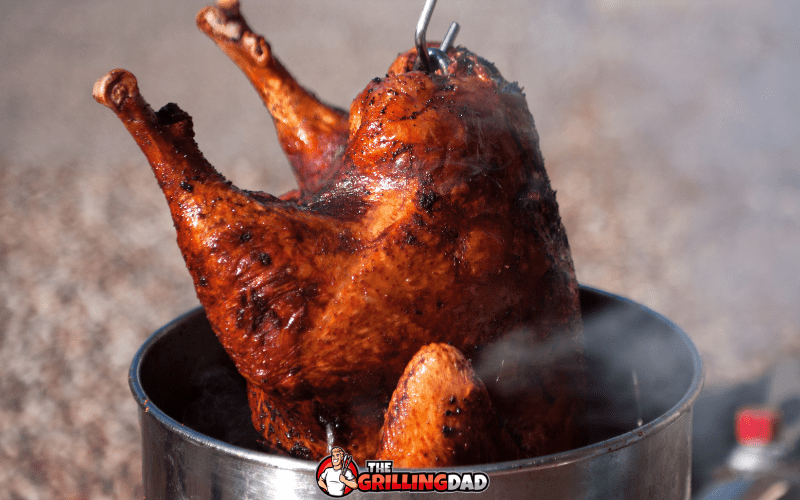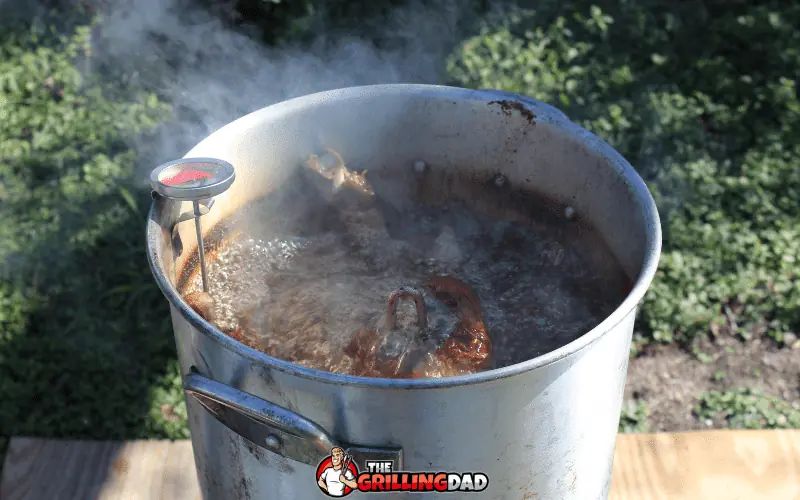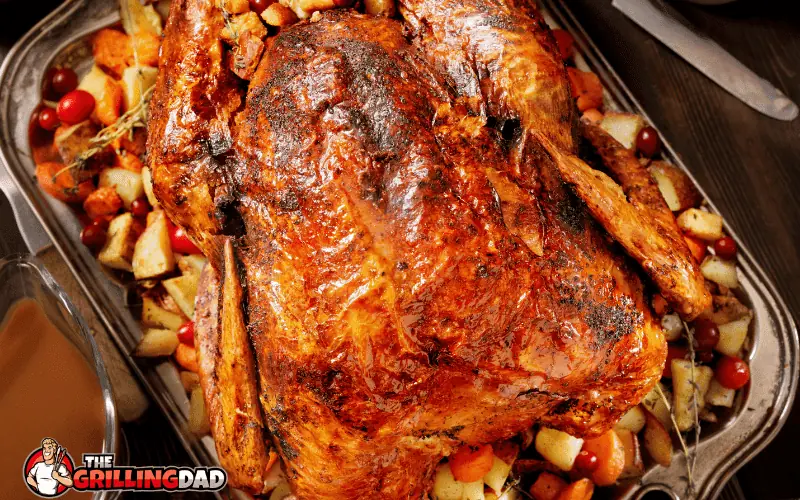Looking for a way to spice up that turkey recipe for the holidays? Are you finding that roasting your turkey simply takes too much time?
You may want to consider a new way to prepare your bird this year that has been quickly gaining popularity in recent years: deep frying!
This TheGrillingDad.com guide will explain:
- What you need to safely deep fry
- How to deep fry a turkey
- Tips for deep frying
- And much more!
Jump to Section
What You Need to Know About Deep Fried Turkey
You may be thinking that deep frying a turkey is difficult and unsafe. However, we can assure you that, if the right precautions and preparations are taken, it can be very easy and safe.
You may also be wondering about how a deep fried turkey differs from a traditional, roasted turkey.
Is it dry? Is it flavorful?
This is the biggest reason that deep fried turkey has seen an increase in popularity recently. Anyone who has tried it will tell you, the taste is far superior to a roast turkey. The white meat is moist, the dark meat is flavorful, and the skin takes on a perfect crisp.
Deep Frying a turkey is much shorter than roasting, as it can be done in around an hour while a roasted turkey can take up to 4 whole hours. This makes deep frying a very attractive method for the holiday season, when you may have a lot to juggle when it comes time for dinner.
Want to learn more about how you can execute a perfect deep fried turkey this holiday season? Keep reading!
Related >> How to Tell if a Turkey is Bad

Equipment Needed to Deep Fry a Turkey
There are many complete kits you can purchase that include everything you’ll need to get started. These normally include a large pot, a hooking system for lowering your turkey, and a burner. Alternatively, you can purchase everything separately. Here is a list of equipment you’ll need:
- A large volume stainless-steel pot (We find that anywhere from 30-60 gallons works best, as you’ll want the most distance between the hot oil and the top of the pot.)
- A turkey frying kit with a lifting hook (Some kits come with baskets, but we recommend using a hook to keep your turkey centered and prevent it from sticking)
- A burner large enough to support your pot and a propane tank to fuel it
- A long-stem thermometer to measure the temperature of the oil and an instant-read meat thermometer to measure the turkey’s internal temperature
- A fire extinguisher in the event of a grease fire
- Heat proof gloves to avoid burns on your hands
- A large baking tray and wire rack to rest your turkey on
We also recommend that you wear a long-sleeved shirt and long pants during the cooking process, for further protection against the hot oil.
Ingredients for Deep Frying a Turkey
Here are the essential ingredients you’ll need for your deep-fried turkey:
- A turkey (We recommend one in the 12-14 pound range)
- A seasoning mix (Avoid seasoning mixes that include sugar, as it will burn easily in the hot oil)
- 5 gallons of oil for deep frying (We recommend canola or peanut oil)
In addition to these ingredients, many people like to inject their birds with a marinade composed of things like lemon juice, oil, butter, and spices. This is completely optional but can bring a whole new level of flavor to your turkey.
Related >> Covering Your Turkey with Foil: When and How to Do It
How to Deep Fry Turkey
Now that you know what you need to deep fry a turkey, lets get into the steps for a perfect cook.
Step 1: Choose your location
You’ll want to find a spot outside with a flat, non-flammable surface in an open area. We find that concrete works best. Make sure there is plenty of space to maneuver around your frying set up. Also make sure that the set up is at least 10 feet away from any building or any combustible material like a wooden deck or patio furniture.
Also make sure that the forecast for the day you’re planning to cook doesn’t call for rain, as water and hot oil can be highly dangerous and cause a grease fire.
Step 2: Measure the oil
Once you’ve set everything up, you’ll want to measure the oil. We do this because using too much or too little oil can be very unsafe, so you’ll need to know how much to use before you start cooking.
Here’s how you can do it:
- Place your turkey in the pot and cover it with water by about half an inch
- Remove the turkey and let excess water drip back into the pot
- Measure the water in the pot or mark the top of it and discard the water. Make sure there is at least 5 inches of clearance from the fill line to the top of the pot to prevent overflowing.
Step 3: Thaw, dry, and season your turkey
Make sure your turkey is fully thawed and then make sure it is fully dried. We recommend leaving it uncovered in the fridge for at least 24 hours after it has thawed, to remove any moisture.
Moisture prevents the skin from crisping up and will also cause the hot oil to pop and splash when you lower your turkey in, so it is essential that it is completely dried before cooking.
After this, apply your seasoning mix. Make sure you have enough to rub over the whole turkey and distribute it underneath the skin to ensure your turkey is thoroughly flavored.
Step 4: Preheat your oil
Make sure your pot is completely dry and fill it to the premeasured line with your oil. Turn the flame on and let your oil come up to temperature. Use your long-stem thermometer to measure the temperature of the oil. You’ll want it to reach a temperature of around 325 F°.
Step 5: Slowly lower your turkey into the oil
Once your oil reaches the target temperature, cut the flame. This is to avoid a grease fire in the result of an overflow. Start lowering your turkey into the oil, very slowly. Placing your turkey in the oil too fast may cause splashing and even an overflow, so it is important to take your time.
The hot oil will start popping as soon as it touches the turkey, so you’ll want to proceed with caution. This process can take up to a full minute, so make sure you don’t rush it.
Step 6: Cook and keep watch
Once your turkey is fully submerged, turn the flame back on and let the oil come up to about 300 F°. The oil temperature will drop pretty significantly, so it’s important to tend to it until you reach your target.
The turkey can take anywhere from 30-45 minutes to cook, so you’ll want to make sure to keep an eye on the set up. Check the temperature in the breast after around 30 minutes. Make sure to cut the flame whenever you take the bird out of the oil. Once the breast has reached 160 F°, you can cut the flame and slowly remove the turkey from the pot.
Step 7: Rest
Place your turkey on a large baking sheet and wire rack to let the excess oil drain. Tent it with foil to preserve the heat and let it rest for at least 20 minutes. This is essential, as a well-rested turkey will ensure the juiciest meat.
Step 8: Serve and enjoy!
You’ll want to carve into your turkey as soon as the resting period is finished since deep-fried turkey is best enjoyed right after the cook.

Deep Fried Turkey Expert Tips
Still on the fence about deep frying your turkey? Here are a few tips that can be of major help during your first fry:
- Never let the oil exceed 325 F°, anything higher can burn your turkey
- Lower your turkey slowly into the oil, dropping it too fast can cause a boil over
- Make sure your turkey is completely dry before cooking, moisture can cause hot oil to pop and spray
- Turn off the flame when placing your turkey in the pot or removing it, to prevent a grease fire
- Set down cardboard on the ground around your set up to prevent oil from staining the concrete
We’ve found these tips to be of massive help when deep frying a turkey for the first time, and we think they’ll definitely help you during your first time!
What Size Turkey Should You Buy for Deep Frying?
We recommend using a smaller bird when frying, something in the 12-14 pound range works best for deep frying. With a larger turkey, you may run into problems with the size of your pot.
We’ve also found that a bigger turkey can cause problems with the doneness of the meat, as the breast can take too long to cook and dry out other parts of the turkey.
Deep frying can definitely be done with a larger turkey, we just find it easiest to stick to smaller ones.
Related >> How Far In Advance Should You Buy a Turkey?
How to Serve Deep Fried Turkey
A deep fried turkey can be enjoyed just like a roast turkey. Simply let it rest and carve into it. The skin will be crispier than a normal turkey, so make sure your carving knives are sharp. We recommend that you leave the legs and wings whole and cut the breast and thighs into 1/4-inch slices.
Once carved, you can serve it by itself or with your favorite side dishes. Deep fried turkey is the perfect thing to serve for a holiday dinner.
Here are our favorite side dishes to serve with your deep fried turkey this holiday season:
- Mashed potatoes
- Mac and cheese
- Glazed carrots
- Stuffing
- Cornbread

How to Store Deep Fried Turkey
You’ll want to carve up your turkey and store it in airtight containers or plastic bags. It can be kept in the fridge for around 3-4 days.
You can also freeze your leftovers. Make sure to use containers that are made to be kept in the freezer. Frozen turkey can keep for up to 3-6 months.
Turkey can be very versatile, and put into things like soups, sandwiches, and salad, so make sure to keep your leftovers for future recipes!
Related >> 3 Ways to Reheat Turkey
How to Dispose of Deep Fried Turkey Oil
Before doing anything with your leftover oil, make sure it has completely cooled. Once done cooking, put the lid on the pot and allow your oil to cool. This can take a few hours after the cooking process.
Once cooled, you can strain it out to use again if you’d like. Use a fine mesh strainer with cheesecloth or a coffee filter to strain thoroughly. This oil can be reused up to 3-4 times. If you want to dispose of it, use a funnel to pour them back into their jugs and take them to a facility that can recycle it correctly. Call your local landfill or recycling center for more information.
Never dispose of oil down any drain in your home, as it can harden and clog your pipes. Also, avoid pouring it in plants or in the sewer, as improperly disposed oil can have harmful effects on the environment.
Final Thoughts on Deep Fried Turkey
While deep frying turkey can seem like a daunting task at first, it is really one of the easier ways to prepare a turkey. With the right planning and execution, deep frying turkey can be a very simple and rewarding task.
The shorter cook time makes it a perfect method for the hectic holiday season, when you may have many different dishes to prepare at once. The taste is also unlike any turkey you’ve had before, and its praises have been sung by many.
If you’ve never tried it and are looking for a new way to prepare your bird for the holidays, we would definitely recommend deep frying your turkey this year. The result will be one of the most delicious turkeys you’ve ever tried, as well as one of the simplest preparations you’ve ever done.






